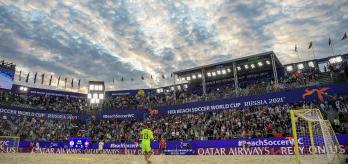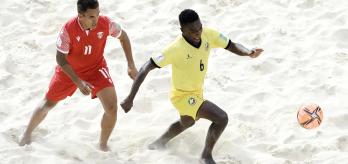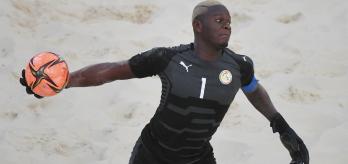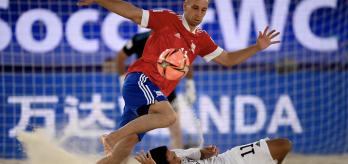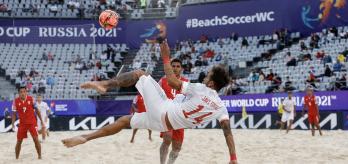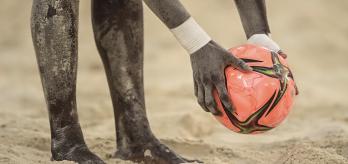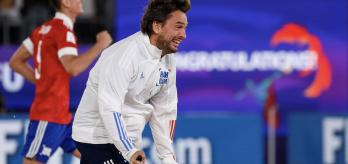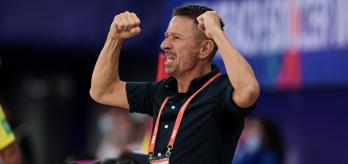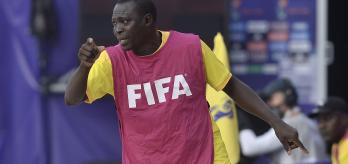Introduction
At the FIFA Beach Soccer World Cup Russia 2021™, the number of goals scored as a result of set plays was 127 out of the total of 302, or 42.05%. This percentage is practically identical to that of Paraguay 2019, confirming once again the extraordinary need for all coaches to devote time and thought to the organisation of attacking and defensive set plays, since these situations are almost always decisive in the final outcome of matches.
Consequently, during the possession phase, teams were forced to play forward much more often. Since the goalkeeper can no longer freely manage the ball during the construction phase (which simultaneously makes it more difficult to create overloads for either of the two wingers, who are almost always marked individually), coaches relied much more frequently on direct attacks, making particular use of throws by their goalkeepers.
Some teams even ended up changing their usual style of play that had characterised them and made them recognisable in previous years. This resulted in substantial changes to the rhythm and speed of the game and to the physical effort required of individual outfield players, who, in turn, are forced to make a more regular contribution to attacking moves, and also to make more frequent attacking and defensive transitions.
Goals statistics
On a statistical level, it is no coincidence that – in addition to an increase in the total goals scored, as mentioned earlier –a large number of goals were scored in both direct attack and counter-attack situations: the greater difficulty in creating overloads, which was previously obtained more easily with the goalkeepers playing with their feet in 2-2, obliged the players to try for more 1v1 individual attacks, while at the same time favouring duels won in the defensive phase and therefore producing an increase in counter-attacks.
A prime example of this was Spain 12-8 Tahiti, where the nine goals scored from open play all stemmed from direct attacks and counter-attacks. In total, out of 175 goals scored from open play, 108 (61.7%) were scored as a result of counter-attacks (55) and direct attacks (53). Of the remaining 38.3% of goals from open play, 25 were scored from individual attacks and 41 from combination attacks (one was an own goal for which the defending team was directly and solely responsible).
The importance of set plays
It can be seen from the table that almost all the teams that progressed the furthest in the competition were those that had the highest percentages in the ratio between goals scored from set plays and total goals scored. The only slightly surprising exception was Brazil (12th, with Mozambique), whose early elimination against all odds was probably partly due to a lack of precision when executing set plays.
Spain and Switzerland (along with El Salvador, who were eliminated in the group stage) had the highest percentages for this ratio, with more than 50% of goals scored from set plays. The Spanish and the Swiss were often infallible with zone 3 free kicks, unlike Japan, for example, who reached the final without scoring from a free kick. However, the Japanese had the highest numbers from corners (like Tahiti, who are not a newcomer to this statistic) and kick-offs (together with Senegal, for whom Ninou Diatta converted three kick-offs in the same match, in their defeat by the Swiss in the match for third place).
World champions Russia once again showcased their creativity and organisation in the development of attacking set plays. For anyone seeking discipline in the preparation of kick-offs, corners and attacking throw-ins, it is always advisable to take inspiration from Mikhail Likhachev’s men, who are almost always perfect in the execution and timing of these fundamental aspects.
Kick-offs
There were 20 goals scored from kick-offs in the competition (19 + one own goal after a kick-off).
Unlike in football and futsal, kick-offs in beach soccer can always be an opportunity to score. A goal scored from a kick-off also has a huge psychological impact on opponents, whether it comes at the beginning of a period – instantly steering the match in a certain direction – or immediately after conceding. In the latter case, it is easy to understand the value of scoring, which signifies an immediate reaction by the team that had just shipped a goal, restoring the equilibrium that was broken only a few moments earlier.
No-one will ever know how the World Cup would have ended if Russia’s Aleksey Makarov had not exploited a kick-off in extra time against Paraguay (a match that Russia went on to win on penalties), and Japan would not have been certain to eliminate Tahiti in the quarter-finals if Takuya Akaguma had not scored from a move arising from kick-off two minutes from the end of extra time.
Preparing well and training for this type of play is crucially important, in both the attacking and defensive phases. A kick-off can not only be decisive in the direct search for a goal, but can also help to put opponents under pressure by obtaining a corner or an attacking throw-in after a shot at goal from the kick-off itself.
Based on its observations, the Technical Study Group (TSG) identified two different ways of executing kick-offs at the FIFA Beach Soccer World Cup Russia 2021:
-
One-pass kick-offs: shot at goal after a single pass
-
Two+ pass kick-offs (combination attack kick-offs): shot at goal after two or more passes
Here are some examples of goals scored from a kick-off after a single pass, which have in turn been divided into:
-
Lift and volley shot
-
Touch and shot off the sand
-
Lateral pass
-
Individual attack kick-off
Here, on the other hand, are some of the goals scored from a kick-off after at least two passes
Corners
At the FIFA Beach Soccer World Cup Russia 2021, 16 goals were scored from corners. Of these 16 goals, 11 (68.75%) were scored by just four teams: Japan, Senegal, Switzerland and Tahiti.
In addition, ten of these corners led to goals after the ball was whipped in towards the back post, in particular, with the last man, the one initially furthest from the goal, making a run into that area. Evidently, this was the most difficult situation to thwart for almost all defences, whether opting for zonal, man-to-man or mixed marking.
Last man attacks the second post
Second post
Most of the other goals from corners were scored by exploiting space at the near post. Of particular note was the magnificent goal by El Salvador’s Frank Velásquez directly from a corner.
First post
Direct from flag
Mozambique’s defensive style was interesting and worth highlighting. When defending corners, the African team always left an attacker in a forward position inside the opposition half, thereby forcing the attacking side to make a difficult choice: either to outnumber the opposition in attack or to hold back in order to prevent a counter-attack with an opposing player ending up one-on-one with the goalkeeper. Here are a couple of examples:
Attacking throw-ins
At the FIFA Beach Soccer World Cup Russia 2021, 17 goals were scored from attacking throw-ins. By “attacking throw-ins”, the TSG means all throw-ins won in zone 4 and in the few metres of zone 3 closest to the goal (up to about 15 metres from the opposing goal), or any attacking throw-ins that translated directly into a scoring opportunity.
In beach soccer, attacking throw-ins can become a lethal weapon, even more so than corners. Firstly, both hands and feet can be used, which allows for greater precision and control in passing; secondly, when the ball leaves the pitch, it is instantly available to the taker who is often already in that position, and this can mean that the opposing team has no time to organise an efficient defensive structure.
This is why a good number of the goals scored from attacking throw-ins at the World Cup came from exploiting disorganised defences and the attacking team’s readiness to catch them off guard, without the need for a particular plan. Here are a few examples:
A good number of successful attacking throw-ins had overhead kicks as the common denominator:
Free kicks and penalties
There were 74 goals scored from free kicks and penalties (which are effectively free kicks awarded in zone 4), or 24.5% of all 302 goals scored in the tournament.
In total, 29 penalties were scored at the World Cup. Switzerland and Japan successfully converted the most spot kicks, with five each (obviously without taking shoot-out penalties after extra time into account). It was interesting that champions and hosts Russia did not score a single penalty at the entire World Cup, but did concede four times from the spot.
As for free kicks, only two were scored from zone 1, with a further six from zone 2 and as many as 37 from zone 3. The two goals from zone 1 were both scored by goalkeepers, who intentionally exploited the bounce of the ball on the sand. Given the long distance from goal, alternatives to shots were also seen very frequently, as shown in the videos:
Even the few goals scored from zone 2 were almost all down to exploiting the uneven surface of the sand, which creates serious difficulties for the goalkeeper when it suddenly changes the ball’s trajectory.
Free kicks from zone 3 are a key factor in every game, and being awarded a foul in this area of the pitch can prove decisive. It is fundamentally important for players to have ability, intelligence and above all, coolness while under pressure in the defensive phase, and to understand when, in certain circumstances, it may be more appropriate to allow the attacker to take a shot at goal (as in the case of an overhead kick, obviously while always applying suitable pressure) rather than to risk intervening more decisively and committing a foul.
For many players at this level, there is no difference in difficulty between scoring from a kick-off from an advanced position in zone 3 and scoring from a penalty, with either powerful or precise shots.










